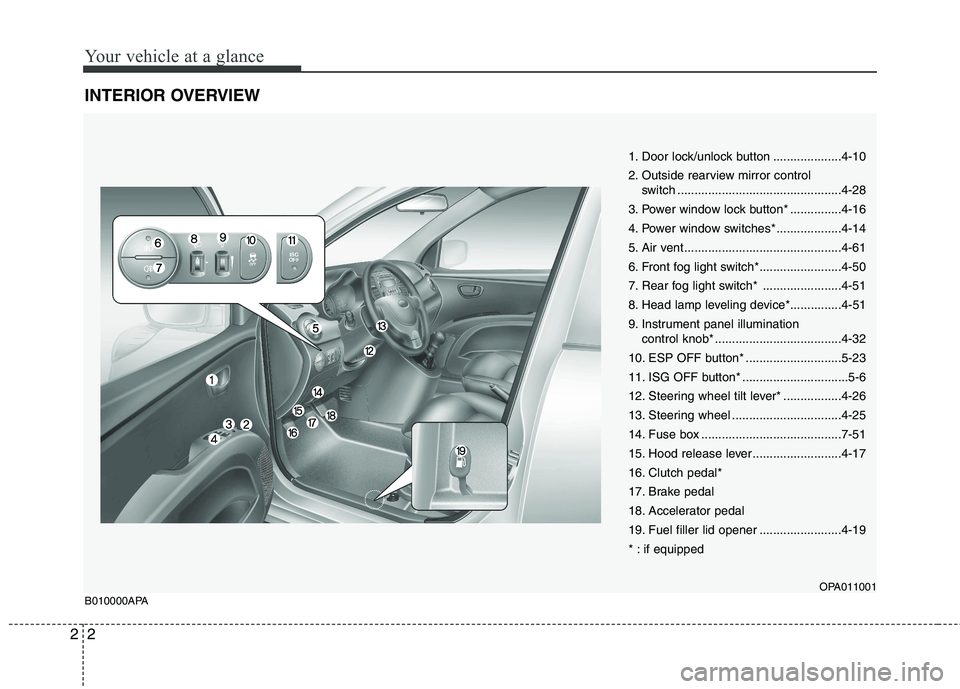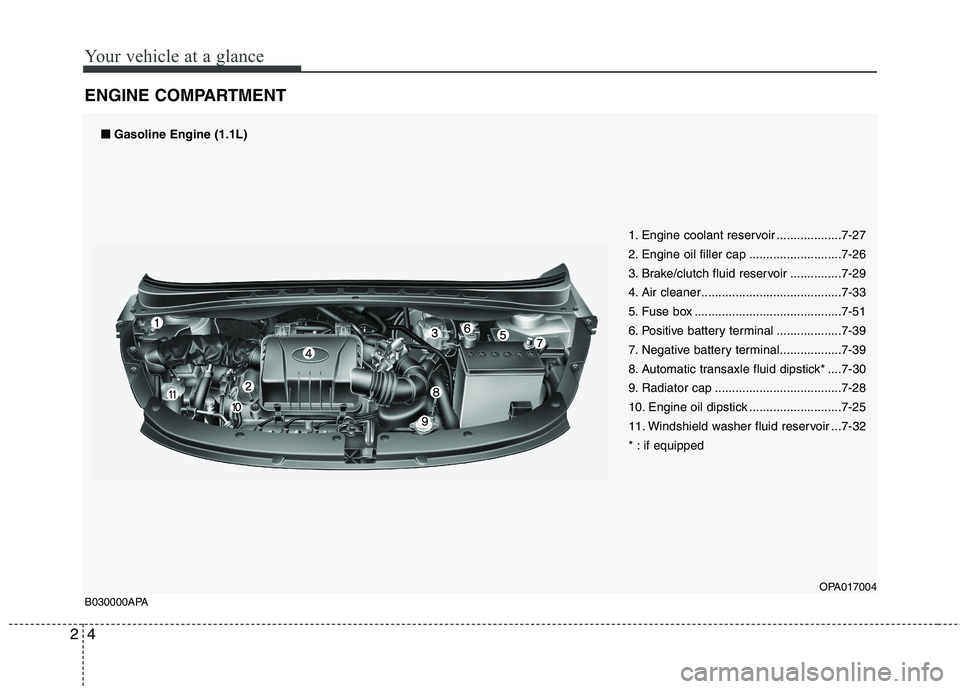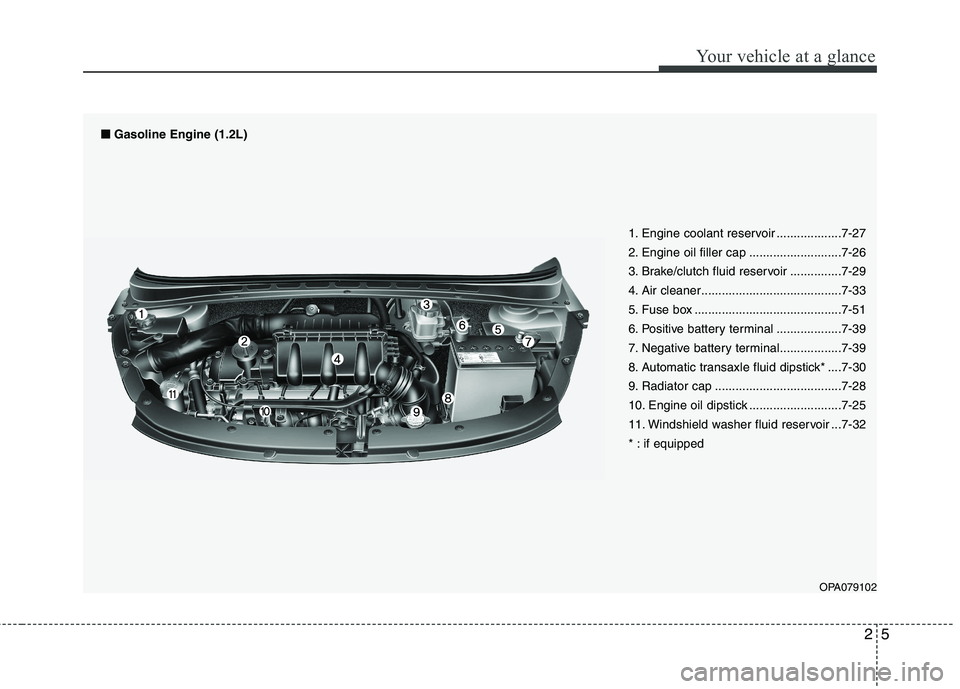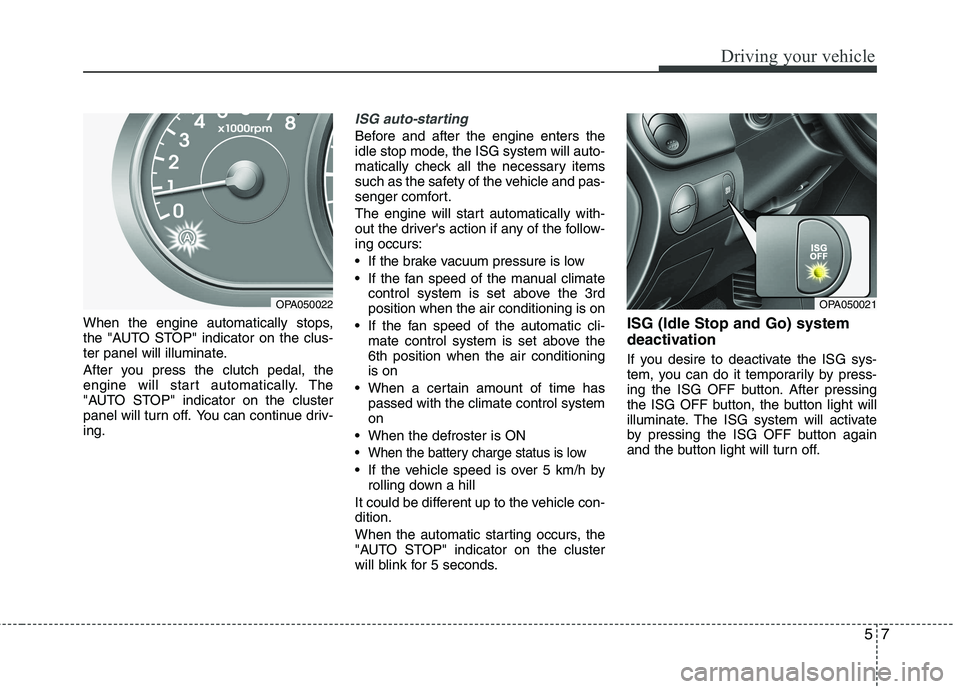clutch HYUNDAI I10 2008 Owners Manual
[x] Cancel search | Manufacturer: HYUNDAI, Model Year: 2008, Model line: I10, Model: HYUNDAI I10 2008Pages: 354, PDF Size: 37.04 MB
Page 15 of 354

Your vehicle at a glance
2
2
INTERIOR OVERVIEW
1. Door lock/unlock button ....................4-10
2. Outside rearview mirror control
switch ................................................4-28
3. Power window lock button* ...............4-16
4. Power window switches* ...................4-14
5. Air vent ..............................................4-61
6. Front fog light switch*........................4-50
7. Rear fog light switch* .......................4-51
8. Head lamp leveling device*...............4-51
9. Instrument panel illumination control knob* .....................................4-32
10. ESP OFF button* ............................5-23
11. ISG OFF button* ...............................5-6
12. Steering wheel tilt lever* .................4-26
13. Steering wheel ................................4-25
14. Fuse box .........................................7-51
15. Hood release lever ..........................4-17
16. Clutch pedal*
17. Brake pedal
18. Accelerator pedal
19. Fuel filler lid opener ........................4-19
* : if equipped
OPA011001
B010000APA
Page 16 of 354

23
Your vehicle at a glance
INSTRUMENT PANEL OVERVIEW
1. Instrument cluster.............................4-31
2. Light control / Turn signals ...............4-48
3. Horn .................................................4-26
4. Wiper/Washer ...................................4-52
5. Driver’s front air bag .........................3-43
6. Ignition switch .....................................5-5
7. Audio* ...............................................4-77
8. Hazard warning flasher switch ........................................4-47, 6-2
9. Seat warmer* .....................................3-7
10. Climate control system* .................4-57
11. Cigarette lighter ..............................4-69
12. Shift lever ................................5-9, 5-12
13. Passenger’s front air bag* ..............3-43
14. Glove box .......................................4-68
15. Clutch pedal*
16. Brake pedal
17. Accelerator pedal
18. Parking brake lever ........................5-19
* : if equipped
OPA011002
B020000APA
Page 17 of 354

Your vehicle at a glance
4
2
ENGINE COMPARTMENT
1. Engine coolant reservoir ...................7-27
2. Engine oil filler cap ...........................7-26
3. Brake/clutch fluid reservoir ...............7-29
4. Air cleaner.........................................7-33
5. Fuse box ...........................................7-51
6. Positive battery terminal ...................7-39
7. Negative battery terminal..................7-39
8. Automatic transaxle fluid dipstick* ....7-30
9. Radiator cap .....................................7-28
10. Engine oil dipstick ...........................7-25
11. Windshield washer fluid reservoir ...7-32
* : if equipped
OPA017004
B030000APA■
■
Gasoline Engine (1.1L)
Page 18 of 354

25
Your vehicle at a glance
1. Engine coolant reservoir ...................7-27
2. Engine oil filler cap ...........................7-26
3. Brake/clutch fluid reservoir ...............7-29
4. Air cleaner.........................................7-33
5. Fuse box ...........................................7-51
6. Positive battery terminal ...................7-39
7. Negative battery terminal..................7-39
8. Automatic transaxle fluid dipstick* ....7-30
9. Radiator cap .....................................7-28
10. Engine oil dipstick ...........................7-25
11. Windshield washer fluid reservoir ...7-32
* : if equipped
■
■
Gasoline Engine (1.2L)
OPA079102
Page 19 of 354

Your vehicle at a glance
6
2
1. Engine coolant reservoir ...................7-27
2. Engine oil filler cap ...........................7-26
3. Brake/clutch fluid reservoir ...............7-29
4. Air cleaner.........................................7-33
5. Fuse box ...........................................7-51
6. Positive battery terminal ...................7-39
7. Negative battery terminal..................7-39
8. Radiator cap .....................................7-28
9. Engine oil dipstick .............................7-25
10. Windshield washer fluid reservoir ...7-32
* : if equipped
■
■
Gasoline Engine (1.0L)
OPA071100N
Page 197 of 354

55
Driving your vehicle
E040000AUN-EU
E040100AUN
1. Make sure the parking brake isapplied.
2. Manual Transaxle - Depress the
clutch pedal fully and shift the
transaxle into Neutral. Keep the clutch
pedal and brake pedal depressed
while turning the ignition switch to the
start position.
Automatic Transaxle - Place the
transaxle shift lever in P (Park).
Depress the brake pedal fully.
You can also start the engine when
the shift lever is in the N (Neutral) position.
3. Turn the ignition switch to START and hold it there until the engine starts (a
maximum of 10 seconds), then
release the key. 4. In extremely cold weather (below
-18°C / 0°F) or after the vehicle has
not been operated for several days, let
the engine warm up without depress-
ing the accelerator.
Whether the engine is cold or warm, it
should be started without depressing
the accelerator.
(Continued)
Never reach for the ignition switch, or any other controls through the
steering wheel while the vehicle is
in motion. The presence of yourhand or arm in this area could
cause a loss of vehicle control, an
accident and serious bodily injuryor death.
Do not place any movable objects around the driver’s seat as they
may move while driving, interferewith the driver and lead to an acci-dent.
STARTING THE ENGINE
WARNING
Always wear appropriate shoes
when operating your vehicle.
Unsuitable shoes (high heels, ski
boots,etc.) may interfere with yourability to use the brake and acceler-ator pedal.
CAUTION
If the engine stalls while you are in motion, do not attempt to move theshift lever to the P (Park) position. If traffic and road conditions permit,
you may put the shift lever in the N (Neutral) position while the vehicleis still moving and turn the ignition switch to the START position in an
attempt to restart the engine.
CAUTION
Do not engage the starter for morethan 10 seconds. If the engine stalls or fails to start, wait 5 to 10 seconds
before re-engaging the starter. Improper use of the starter maydamage it.
Page 198 of 354

Driving your vehicle
6
5
Your vehicle may be equipped with the ISG system, which reduces fuel con-
sumption by automatically shutting down
the engine, when the vehicle is at astandstill.
(For example : red light, stop sign and
traffic jam)
The engine starts automatically as soon
as the starting conditions are met.
✽✽
NOTICE
When the engine automatically starts by
the ISG system, some warning lights
(ABS, ESP, ESP OFF or Parking brake
warning light) may turn on for a few
seconds.
This happens because of low battery
voltage. It does not mean the system is
malfunctioning.
ISG (Idle Stop and Go) Operation
The ISG system is ON whenever the igni-
tion switch is turned on.
The engine will enter the idle stop (AUTO
STOP) mode automatically when all ofthe essential conditions are met. The gear is not engaged & clutch not
pressed
The vehicle speed should be over 10km/h at least once after key starting
or idle starting.
The vehicle speed should be below 5km/h
The outside temperature is between 2°C to 35°C
The engine coolant temperature is not too low
Battery charge status is adequately high
The driver's seat belt is fastened
The driver's door and hood are closed.
It could be different up to the vehicle con- dition.
ISG (IDLE STOP AND GO) SYSTEM (IF EQUIPPED)
OPA050020
Page 199 of 354

57
Driving your vehicle
When the engine automatically stops,
the "AUTO STOP" indicator on the clus-
ter panel will illuminate.
After you press the clutch pedal, the
engine will start automatically. The
"AUTO STOP" indicator on the cluster
panel will turn off. You can continue driv-ing.
ISG auto-starting
Before and after the engine enters the
idle stop mode, the ISG system will auto-
matically check all the necessary items
such as the safety of the vehicle and pas-
senger comfort.
The engine will start automatically with-
out the driver's action if any of the follow-ing occurs:
If the brake vacuum pressure is low
If the fan speed of the manual climatecontrol system is set above the 3rd position when the air conditioning is on
If the fan speed of the automatic cli- mate control system is set above the6th position when the air conditioningis on
When a certain amount of time has passed with the climate control systemon
When the defroster is ON
When the battery charge status is low
If the vehicle speed is over 5 km/h by rolling down a hill
It could be different up to the vehicle con-dition.
When the automatic starting occurs, the
"AUTO STOP" indicator on the cluster
will blink for 5 seconds. ISG (Idle Stop and Go) system
deactivation
If you desire to deactivate the ISG sys-
tem, you can do it temporarily by press-
ing the ISG OFF button. After pressing
the ISG OFF button, the button light will
illuminate. The ISG system will activate
by pressing the ISG OFF button again
and the button light will turn off.
OPA050022OPA050021
Page 201 of 354

59
Driving your vehicle
E050000AUNE050100BPA
Manual transaxle operation
The manual transaxle has 5 forward
gears.
This shift pattern is imprinted on the shift
knob. The transaxle is fully synchronized
in all forward gears so shifting to either a
higher or a lower gear is easily accom-plished.
Press the clutch pedal down fully while
shifting, then release it slowly.
The gearshift lever must be returned to
the neutral position before shifting into R
(Reverse).
The ring (1) located immediately below
the shift knob must be pulled upward
while moving the shift lever to the R posi-
tion. (Type B)
Make sure the vehicle is completely
stopped before shifting into R (Reverse).
Never operate the engine with thetachometer (rpm) in the red zone.
MANUAL TRANSAXLE (IF EQUIPPED)
The shift lever can be moved without pulling
the ring (1).
The ring (1) must be pulled up while moving
the shift lever.
CAUTION
When downshifting from fifthgear to fourth gear, caution
should be taken not to inadver- tently press the gear shift leversideways in such a manner thatsecond gear is engaged. Such a
drastic downshift may cause theengine speed to increase to the point that the tachometer will
enter the red-zone. Such over- revving of the engine may possi-bly cause engine damage.
Do not downshift more than 2 gears or downshift the gear when
the engine is running at highspeed (5,000 RPM or higher). Such a downshifting may damagethe engine.
OPA057008
OPA057002
Type A
Type B
Page 202 of 354

Driving your vehicle
10
5
During cold weather, shifting may be
difficult until the transaxle lubricant has
warmed up. This is normal and not
harmful to the transaxle.
If you've come to a complete stop and it's hard to shift into 1st or R(Reverse),
put the shift lever in N(Neutral) position
and release the clutch. Press the
clutch pedal back down, and then shift
into 1st or R(Reverse) gear position. E050101AUNUsing the clutch
The clutch should be pressed all the way
to the floor before shifting, then released
slowly. The clutch pedal should always be
fully released while driving. Do not rest
your foot on the clutch pedal while driv-
ing. This can cause unnecessary wear.
Do not partially engage the clutch to hold
the car on an incline. This causes unnec-
essary wear. Use the foot brake or park-
ing brake to hold the car on an incline. Do
not operate the clutch pedal rapidly and
repeatedly.
CAUTION
To avoid premature clutch wear
and damage, do not drive with
your foot resting on the clutchpedal. Also, don’t use the clutchto hold the vehicle stopped on an uphill grade, while waiting for atraffic light, etc.
Do not use the shift lever as a handrest during driving, as thiscan result in premature wear ofthe transaxle shift forks.
WARNING
Before leaving the driver’s seat, always set the parking brake fully
and shut the engine off. Thenmake sure the transaxle is shifted
into 1st gear when the vehicle is
parked on a level or uphill grade,
and shifted into R (Reverse) on a
downhill grade. Unexpected and
sudden vehicle movement canoccur if these precautions are not
followed in the order identified.
If your vehicle has a manual transaxle not equipped with a
ignition lock switch, it may moveand cause a serious accident
when starting the engine without
depressing the clutch pedal whilethe parking brake is released and
the shift lever not in the N(Neutral) position.